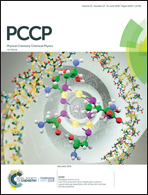Modifications in coordination structure of Mg[TFSA]2-based supporting salts for high-voltage magnesium rechargeable batteries†
Abstract
To achieve a sustainable-energy society in the future, next-generation highly efficient energy storage technologies, particularly those based on multivalent metal negative electrodes, are urgently required to be developed. Magnesium rechargeable batteries (MRBs) are promising options owing to the many advantageous chemical and electrochemical properties of magnesium. However, the substantially low working voltage of sulfur-based positive electrodes may hinder MRBs in becoming alternatives to current Li-ion batteries. We proposed halide-free noncorrosive ionic liquid-based electrolytes incorporating Mg[TFSA]2 for high-voltage MRB applications. Upon the complexation of Mg[TFSA]2 with tetraglyme (G4) and strict control of the liquid states, the electrolytes achieved excellent anodic stability up to 4.1 V vs. Mg2+/Mg even at 100 °C. The modest electrochemical activities for magnesium deposition/dissolution in the [Mg(G4)][TFSA]2/ionic liquid electrolyte can be improved by certain modifications to the coordination state of [TFSA]−. Dialkyl sulfone was found to be effective in changing the coordination state of [TFSA]− from associated to isolated (free). This coordination change successfully promoted magnesium deposition/dissolution reactions, particularly in the coexistence of ether ligand. By contrast, the coordination of Mg2+ by strongly donating agents such as dimethyl sulfoxide and alkylimidazole led to the complexes inactive electrochemically, suggesting that interaction between Mg2+ and coordination agents predominates the fundamental electrochemical activity. We also demonstrated that an enhancement in the electrochemical activity of electrolytes contributed to improvements in the cycling ability of magnesium batteries with 2.5 V-class MgMn2O4 positive electrodes.
![Graphical abstract: Modifications in coordination structure of Mg[TFSA]2-based supporting salts for high-voltage magnesium rechargeable batteries](/en/Image/Get?imageInfo.ImageType=GA&imageInfo.ImageIdentifier.ManuscriptID=C9CP01400D&imageInfo.ImageIdentifier.Year=2019)
- This article is part of the themed collection: 2019 PCCP HOT Articles


 Please wait while we load your content...
Please wait while we load your content...